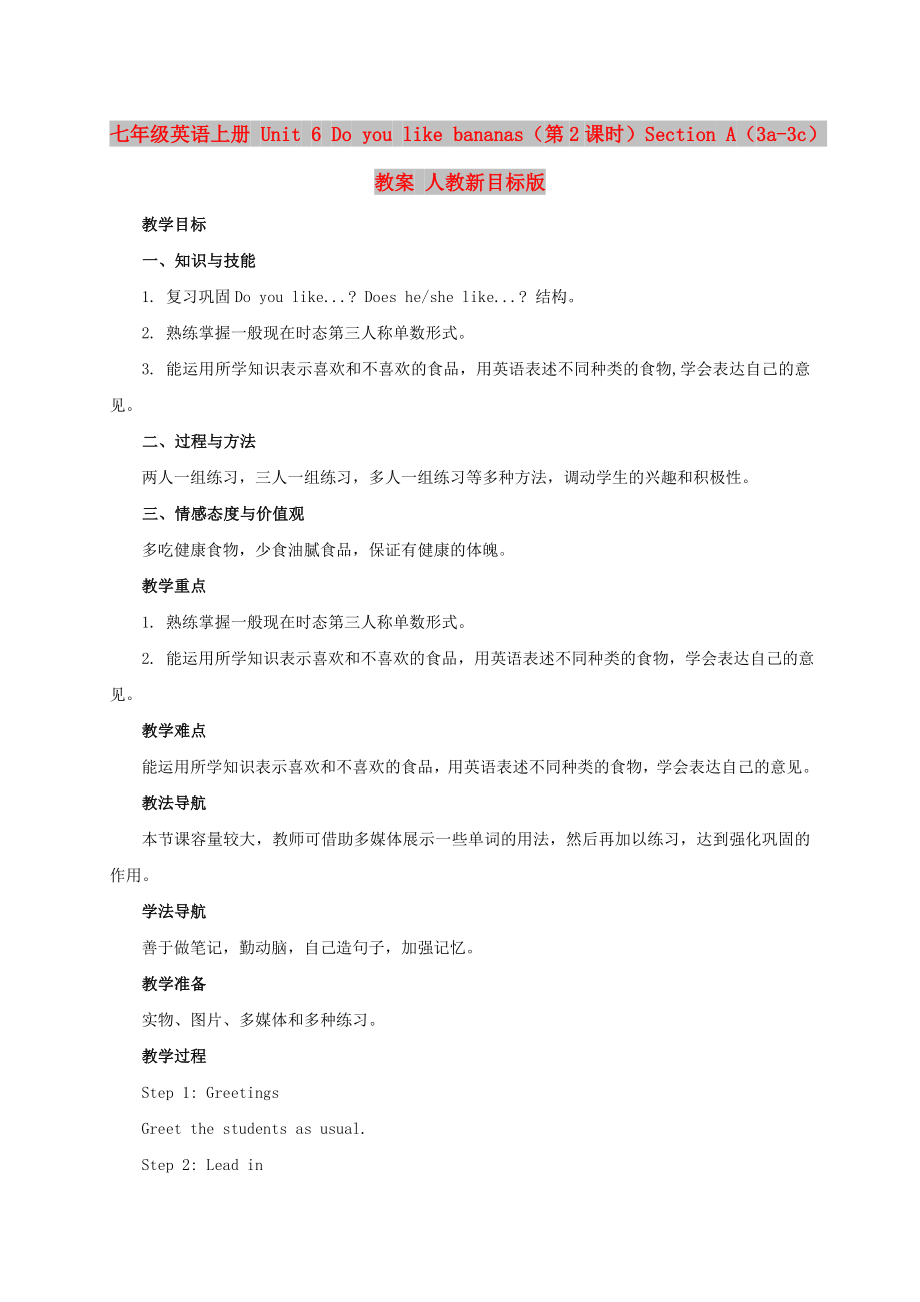《七年級(jí)英語上冊 Unit 6 Do you like bananas(第2課時(shí))Section A(3a-3c)教案 人教新目標(biāo)版》由會(huì)員分享��,可在線閱讀���,更多相關(guān)《七年級(jí)英語上冊 Unit 6 Do you like bananas(第2課時(shí))Section A(3a-3c)教案 人教新目標(biāo)版(4頁珍藏版)》請?jiān)谘b配圖網(wǎng)上搜索����。
1����、七年級(jí)英語上冊 Unit 6 Do you like bananas(第2課時(shí))Section A(3a-3c)教案 人教新目標(biāo)版
教學(xué)目標(biāo)
一����、知識(shí)與技能
1. 復(fù)習(xí)鞏固Do you like...? Does he/she like...? 結(jié)構(gòu)��。
2. 熟練掌握一般現(xiàn)在時(shí)態(tài)第三人稱單數(shù)形式��。
3. 能運(yùn)用所學(xué)知識(shí)表示喜歡和不喜歡的食品���,用英語表述不同種類的食物,學(xué)會(huì)表達(dá)自己的意見�����。
二����、過程與方法
兩人一組練習(xí)�����,三人一組練習(xí)����,多人一組練習(xí)等多種方法���,調(diào)動(dòng)學(xué)生的興趣和積極性。
三�����、情感態(tài)度與價(jià)值觀
多吃健康食物�����,少食油膩食品��,保證有健康的體魄�����。
教學(xué)重點(diǎn)
1. 熟練掌
2�����、握一般現(xiàn)在時(shí)態(tài)第三人稱單數(shù)形式�����。
2. 能運(yùn)用所學(xué)知識(shí)表示喜歡和不喜歡的食品���,用英語表述不同種類的食物��,學(xué)會(huì)表達(dá)自己的意見����。
教學(xué)難點(diǎn)
能運(yùn)用所學(xué)知識(shí)表示喜歡和不喜歡的食品����,用英語表述不同種類的食物,學(xué)會(huì)表達(dá)自己的意見����。
教法導(dǎo)航
本節(jié)課容量較大,教師可借助多媒體展示一些單詞的用法��,然后再加以練習(xí)���,達(dá)到強(qiáng)化鞏固的作用����。
學(xué)法導(dǎo)航
善于做筆記�����,勤動(dòng)腦,自己造句子����,加強(qiáng)記憶。
教學(xué)準(zhǔn)備
實(shí)物���、圖片���、多媒體和多種練習(xí)����。
教學(xué)過程
Step 1: Greetings
Greet the students as usual.
Step 2: Lead in
找朋友:為每個(gè)問句
3、找出正確的回答���。
( ) Do you like French fries?
A. No, she doesn’t. She likes carrots.
( ) Does she like carrots?
B. They have chicken, French fries and carrots.
( ) Does she like broccoli?
C. Yes, I do.
( ) Do you like ice cream?
D. No, I don’t. I like ice cream.
( ) What do they hav
4�����、e for dinner?
E. Yes, she does.
參考答案:D, E, A, C, B
Step 3: Revision
Practice the dialogue: Do you like ...? Yes, I do./No, I don’t.
Step 4: Practice
Ask a student: Do you like bananas?
And then ask the other students: Does he/she like bananas?
Help them to answer: Yes, he/she does. No,
5�����、 he/she doesn’t.
Ask the students to work in groups of three to practice the dialogue.
Step 5: Make a survey
Work in groups and make a survey.
調(diào)查個(gè)人食物愛好情況及原因���,完成下列表格內(nèi)容�����。
Name
like
why
don’t like
why not
請小組代表匯報(bào)總結(jié)調(diào)查情況�����。
Step 6: Exercises
Do the following exercise
6���、s.
1. Li and Wang like French fries. (改為否定句)
They _______ __________ French fries.
2. Does Tom like strawberries? (否定回答)
______________, _______________.
3. She doesn’t have lunch. (變?yōu)榭隙ň?
She ___________ lunch.
4. The photos are on the wall. (對劃線部分提問)
__________ ___________ the photos?
5.
7、There is a banana in the picture. (改為復(fù)數(shù)句)
There ________ _______ _________ in the picture.
參考答案:
1. don’t, like 2. No, he, doesn’t 3. has 4. Where, are
5. are, some/many, bananas
Step 7: Homework
1. Finish the dialogue.
A: Excuse me, who’s that boy?
B: Oh, that’s my brother, Ben.
A
8�����、: Does he (1) hamburgers?
B: Yes, he likes them (2) (3) .
A: Does he like ice cream?
B: (4) , he likes it, too.
A: Does he like French fries?
B: (5) , he (6) like them at all.
2. 介紹一下你的家人一日三餐的飲食及你和你的家人喜歡和不喜歡的食物����。不少于50字。
參考答案:
1. (1)like (2)very (3)much (4)Yes (5)
9����、No (6)doesn’t
2. (略)
課堂作業(yè)
改錯(cuò)
1. Does the old man likes running every morning? ( ) ________
A B C D
2. They have the lunch at about twelve. ( ) ________
A B C D
3. Does your brother plays basketball? ( ) ________
A B C D
4. My sister have a banana in her backpack. ( ) ________
A B C D
參考答案:1. B 改為like 2. A 去掉the 3. C 改為play 4. A 改為has
教學(xué)反思
通過問卷調(diào)查,鞏固了所學(xué)知識(shí)��,了解了同學(xué)的喜好,增進(jìn)同學(xué)之間的了解和友誼���,又培養(yǎng)了團(tuán)結(jié)合作精神����,一舉多得��。
 七年級(jí)英語上冊 Unit 6 Do you like bananas(第2課時(shí))Section A(3a-3c)教案 人教新目標(biāo)版
七年級(jí)英語上冊 Unit 6 Do you like bananas(第2課時(shí))Section A(3a-3c)教案 人教新目標(biāo)版

